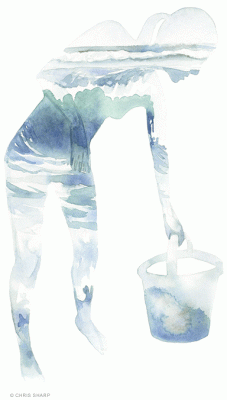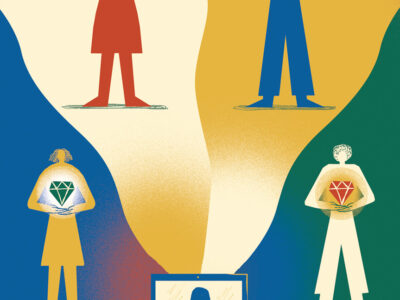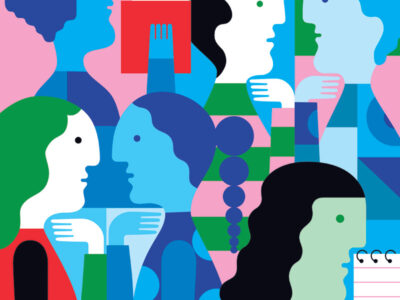Approaching enlightenment in the Himalayas, one bucket at a time.

By Caroline Kee | Last fall, mired in the depths of a junior-year rut, I watched a TED talk about cold-shower therapy. I was searching for some little scrap of enlightenment anywhere, even in the corners of my bathroom. The upbeat pony-tailed man standing with his arms crossed on TED’s classic black stage seemed to be speaking directly to me.
He said the showers would be good for my discipline and self-control. Forcing oneself to endure the discomforts of extended exposure to cold water, he claimed, was a mechanism for strengthening the mind over the body. I believed him, and climbed into the vintage clawfoot bathtub in my old West Philadelphia row house with a sense of determination.
I tried the cold showers for one week. If there was some grand point to them, it eluded me. Beyond slightly increasing my tolerance for the cold, I could discern no real benefit. I was a shivering silhouette, huddled behind the shower curtain scowling at my bottle of Pantene in discomfort as I listened to my roommates laughing over shots of whiskey. The showers swiftly began feeling like just another step in my banal daily routine. Presently, I came down with a bad cold. Maybe it was the showers, maybe it was just November.
The following May, I landed in Delhi for a three-month internship with a rural development NGO. I’d made it through the school year—and to the end of a tumultuous two-year relationship—and I was ready to throw myself into work. I would be working for a team of foreign doctors at the NGO’s hospital and researching traditional healers for my thesis.
Yet, I was not ready to work at all. I was ready to find myself. It sounds selfish, but I couldn’t tell you truthfully that I went halfway across the world for a worldly academic experience to boost my resumé—as so many of my fellow students do. I thought that if there was any cure for a 21-year-old’s anxiety about the world moving too fast beneath her feet, it was volunteering in poverty-stricken India.
My journey began with an intense sense of dislocation. When I arrived in India, I had no sense of my body’s connection to its surroundings. I felt as though I was watching myself on film.
After sweating in the chaotic heat of Delhi for just two days, I was on the move again, embarking on a 10-hour train trip into the Kumaon foothills of the Himalayas. I held a rose-flavored lassi as fields of wheat and sorghum flew by the window in a yellow blur. The fields were freckled with people squatting; how odd, I thought, to see people farming this way. Little did I know, they were not farming. I was naïve to an entire nation, and to many cultures.
The Kumaon region was as foreign to fellow interns from Delhi and Bangalore as it was to me. Our stop was one of the train’s last. Palms had become pine trees and the air was fresh and cool. From the station we traveled four hours by jeep over a nauseatingly bumpy road to reach our final destination.
Our first week or so at the NGO was set aside for immersion; we learned to eat, sleep, speak, walk, and practice hygiene the Kumaoni way. I was grateful for the time, because I knew it would be impossible to conduct any research as a complete alien. Besides, I needed to seriously brush up on my Hindi before I could really do anything at all.
It was also an astonishingly lovely place to immerse oneself in. The NGO was nestled into lush green jungle abutting an impossibly peaceful hill station, facing distant ridges and peaks of the Himalayan range that rioted with color at sunset. Women draped in saris as vivid as the local bright-pink flowers hummed as they walked to the NGO’s herb garden to collect fragrant oregano and sage. They carried massive bundles on their heads with poise and elegance, something I never quite got the knack for without nearly giving myself a neck injury. We ate bitter melon and eggplants from the garden, spiced with masala over hot lentil soup. I found companionship in Devrani, a small black Labrador, who padded behind me on hikes up to the nearest temple. I am not a particularly religious person, but there was something about the crimson and yellow buildings, draped in bells and ribbons and deity statues, that made me feel like a member of the larger spiritual thought collective. I joked with the other interns that we’d been secretly spirited away to a posh rehab center in California—which, when I thought about it, was exactly what I needed after my stressful, neurotic, pre-med year at Penn.
One of the first orders of the immersion business was learning how to get clean—in the shower, that is.
There was no cold-shower therapy at the NGO, at least not by that name. There were just Himalayan bucket showers. But if anything held the promise of testing the mind’s resilience against the body’s complaints, this had to be it. I would crouch in the corner of a small tiled room, above a sketchy drain, while a tap slowly filled a bucket with cold, possibly dirty water. Nearby was a small pitcher—the same one that was employed in lieu of toilet paper, which was a whole other story—which I dipped into the bucket to dump on my body.
An ambitious soul might have begun with her back and shoulders, but I usually copped out and eased in with my legs. I would slowly move upward, as though easing into a swimming pool in May, when it’s still too chilly to swim.
The first few times, it felt draconian. The other interns could hear my gasps through the door, which grew louder with each freezing pitcher until my upper body finally became acclimated. They said it sounded like a weird mix of pleasure and pain, which is exactly what it was. Halfway into the bucket shower, the suffering would transform into the sublime. I wasn’t sure if it was my body adjusting to the water temperature, or the totalizing experience of full-body numbness, but it almost felt like a high.
Soon the cold water became addicting, thrilling. You might say I became an evangelist. Side effects included shiny hair and glowing skin. Supposedly, the dormitory’s solar-powered water heater did work on occasion, but I never found out exactly how, and quite frankly I was okay with that. I could say the experience made me feel grateful for the unlimited hot water I had back at home, but it really just made me feel wild, and mountainous. I liked to bucket shower in the morning.
I am not sure if the two are directly correlated, but as the showers got easier, I felt happier. Everything about India that I found impossible to live with at first—the men staring, over-spiced lentils, squat toilets—suddenly became charming. I found myself smiling more than I had in months.
And certainly more than I had in my West Philadelphia bathtub. There was something about shivering in the cold air of that tile room, with freezing wet hair, as the morning sunlight flooded over the Himalayas through the window, that made me feel like a real human being uniting with a real human place. The ritual connected me to the daily life of the people who live in Kumaon, whose discomforts range far and wide beyond a cold bucket shower.
“It has become habit,” my summer neighbors would often say, almost reflexively, in reference to anything from cooking in smoke-filled unventilated kitchens to hauling 75-pound sacks of wheat four miles over uneven terrain. The phrase articulated both the discomforts of life and why enduring them is a cornerstone of happiness. There is no coldness or heaviness borne onto us from the physical world which can oppress the spirit, only that which comes from within ourselves. I learned from my Kumaon neighbors that it is possible to become upset only about the parts of life that are truly upsetting—and for me, there was little to be sad about. You could say that the cold bucket showers were my first Kumaoni habit. I never stopped shivering, but I no longer felt cold.
Perhaps it really is therapeutic.





I’ve found your article beautiful and compelling! I’m planning to share it with my students.
Being originally from India, 54 years ago and visiting frequently I enjoyed your description of the visit to India. Glad you enjoyed it.
Kumaon is to India what a National Park will be to U.S. Sanitized and attractive. To see real India one needs to travel to the bigger cities first and then the hinterlands.
Hope you visit India again for a longer time and see more of it.
Rumy Hilloowala, Graduate School of Medicine, U. of Penn. 1960-61